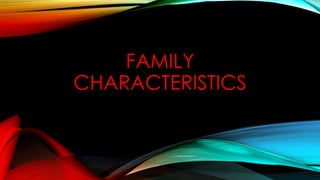
Family characteristics
- 2. CHARACTERISTICS OF FAMILY MEMBERS • Parents • Extended Family • Siblings • Family Member’s Disabilities • Extent of Disability • Age of Onset • Developmental Delay • Child Development Stages
- 3. PARENTS increased stress, take a toll on mental and physical health, make it difficult to find appropriate and affordable child care, and affect decisions about work, education/training, having additional children, and relying on public support. It may be associated with guilt, blame, or reduced self-esteem repercussions for the quality of the relationship between the parents, their living arrangements, and future relationships and family structure lower rates of social participation
- 4. EXTENDED FAMILY • Extended Family - a family that extends beyond the nuclear family, including grandparents, aunts, uncles, and other relatives, who all live nearby or in one household increased stress, take a toll on mental and physical health
- 5. SIBLINGS • Sibling -each of two or more children or offspring having one or both parents in common; a brother or sister • siblings of children with disability were more likely than siblings residing with typically developing children to have problems with interpersonal relationships, psychopathological functioning, functioning at school, and use of leisure time
- 6. FAMILY MEMBER’S DISABILITIES EXTENT OF DISABILITY AGE OF ONSET • Positive: it can broaden horizons, increase family members' awareness of their inner strength, enhance family cohesion, and encourage connections to community groups • Disability places a set of extra demands or challenges on the family system • Many of these challenges cut across disability type, age of the person with the disability, and type of family in which the person lives. • Financial burden: health, education, and social services • making accommodations to the home; transportation; and medications and special food • knowing what services and programs one is eligible for and then working with a bureaucracy to certify that eligibility • Coordination of services among different providers • exhaustion and fatigue, taxing the physical and emotional energy of family members. • The age of the person when the disability emerges is associated with different impacts on the family • in late adulthood, more expectable, less disruptive to family psychologically • Earlier in life, out of norm, impact on person and family greater. • From birth: life and identity are shaped around disability. It may be easier to adjust
- 7. EXTENT AND AGE OF DISABILITY • Age of parents when child diagnosed also important to how family responds. • Teenage parents greater risk for experiencing poor adaptation • Older parents have greater risk of having child with certain disabilities. May lack stamina for extra burden of care required, may fear own mortality and concern for who will care for child
- 8. DEVELOPMENTAL DELAY CHILD DEVELOPMENT STAGES • Developmental delay refers to children who experience significant variation in the achievement of expected milestones for their actual or adjusted age • The quality of child-caregiver interaction may be compromised when a child has a disability. Several studies have shown that there are differences in parent-child interaction when a child is disabled—mothers or caregivers of children with disabilities usually dominate interactions more than mothers or caregivers of children without disabilities • Child development stages :A developmental milestone is an ability that is achieved by most children by a certain age. Developmental milestones can involve physical, social, emotional, cognitive and communication skills such as walking, sharing with others, expressing emotions, recognizing familiar sounds and talking
- 9. INDIVIDUALISM VS. COLLECTIVISM • Culture refers to the patterns ov values and learned behaviors that are shared and transmitted from generation to generation by members of a social group. • “Values” include beliefs, assumptions, and attitudes. • Elements of both individualism and collectivism in any culture. • The difference is in the relative importance that each culture places on these contrasting values. • Where each person is at on the continuum of values depends how closely they identify with traditional culture, level of education, and the ethnic mix of their community. • People are considered individuals, whose identities are based on their personal experiences, accomplishments, challenges, relationships with people • Collective view is that people are part of a larger group, (extended family, village) • Identity is based on one’s roles and experiences within that group.
- 10. INDIVIDUALISM VS. COLLECTIVISM CONT. • ¾ of world’s cultures considered collectivistic • Orientation to self or group • Individualistic view leads to emphasis of self-oriented values and skills that support independent living. • Collectivistic view leads to emphasis on group-oriented values and skills that contribute to effectively filling roles within the family or other group. The young adult may be expected to remain at home and fulfuil l roles within the family
- 11. SYSTEM-CENTERED • The belief that the educator is the only expert and in control of all educational decisions • All learners must fit into existing programs based on labels • Curriculum decisions based on those labels • Family input not encouraged
- 12. RELATIONSHIP-CENTERED • A transdisciplinary team approach to education • Education plans based on knowledge of individual learner, including strengths and challenges • Gathers information from child, family and others supporting the child • ALL team members made decisions and solve problems based upon individual needs of child and family, NOT diagnosis, label or tradition • Everybody working for the best education possible • Important to have a vision for the student for the future